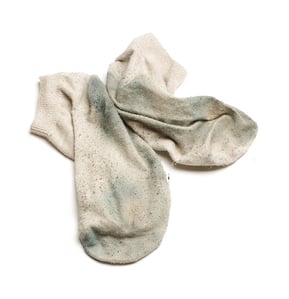 If you have wondered what was really making your clothes smell before you threw them into the wash, and even after they were supposedly cleaned, you are not alone. Scientists from Northrumbia University recently published a study in the Journal of Chromatography that revealed the molecules that make your socks stink. Beyond the dirt and sweat, believe it or not there are six volatile organic compounds (VOCs) that simply can’t be washed out in traditional eco-friendly cycles (68 degrees Fahrenheit). In other words, the stinky VOCs survive the wash.
If you have wondered what was really making your clothes smell before you threw them into the wash, and even after they were supposedly cleaned, you are not alone. Scientists from Northrumbia University recently published a study in the Journal of Chromatography that revealed the molecules that make your socks stink. Beyond the dirt and sweat, believe it or not there are six volatile organic compounds (VOCs) that simply can’t be washed out in traditional eco-friendly cycles (68 degrees Fahrenheit). In other words, the stinky VOCs survive the wash.
There is no doubt that more people are paying more attention to the environmental footprint of their day-to-day activities. Washing clothes without hot water or using detergents that are less environmental friendly have become more viewed as ways to be more friendly to the environment. Scientists argue that because of this increasing awareness of the ecological impacts of washing clothes, it’s “important to understand why dirty clothes smell, in order to find the best way to clean them.” The VOCs “could be used to test the effectiveness of washing at different temperatures.”
As part of the study, six men and two women were given a pair of socks. The volunteers were then asked to wash their feet with tap water, dry them and them put on the socks for 10 hours in a pre-determined pair of shoes. The socks were then stored in separate bags over night. In addition, nine men were asked to wear a t-shirt for two-three hours while participating in a 5v5 soccer tournament. Following the games, the t-shirts were bagged and refrigerated.
A few researchers were given the unfortunate assignment of grading the socks and t-shirts on the odor using a scale of one to 10 with 10 being the smelliest. The researchers took samples from the toe, ball and heel of the sock and from the under-arm portion of the t-shirt.
“After sampling, the researchers washed the t-shirts and socks in a Tergotometer - a lab machine made up of several miniature washing machines - at 20˚C, using non-perfumed detergent. They tested samples for VOCs after washing while they were still wet, and after drying.”
To test the samples, scientists used a method called static headspace - multi-capillary column - gas chromatography - ion mobility spectrometry (SHS-MCC-GC-IMS). From the samples, the team identified six main VOCs contributing to the smell:
- Butyric acid (strong, rancid butter-like odor),
- Dimethyl disulfide (unpleasant, onion-like odor),
- Dimethyl trisulfide (powerful odor),
- 2-heptanone (banana-like fruity odor),
- 2-nonanone (fruity, floral, fatty, herbaceous odor) and
- 2-octanone (apple-like odor).
The scientists concluded that the VOCs persist pre- and even post-wash at low temperatures, using a non-perfumed granular laundry detergent. “While further studies are required to investigate the influence of the washing temperature on the laundry process it is evident that the presence and identification of key VOCs can provide a guide to its effectiveness. The presence of butyric acid, dimethyl disulfide and dimethyl trisulfide provide a powerful indicator of malodour in the laundry process.”
Teledyne Tekmar draws on our experience as a leader in low-level VOC analysis with the HT3 and the Versa Static and Dynamic Headspace Systems.
Versa is the perfect solution for applications which require all the advantages of headspace analysis and is economical to fit any budget. Click for more information on the Versa.
Dramatic improvements in sensitivity are achieved with the HT3 Dynamic Headspace option, while maintaining the ruggedness and reliability of a traditional Static Headspace instrument. Click for more information on the HT3.
